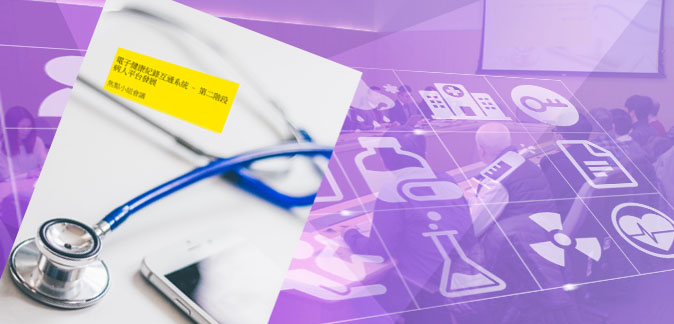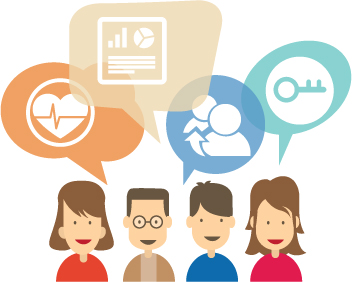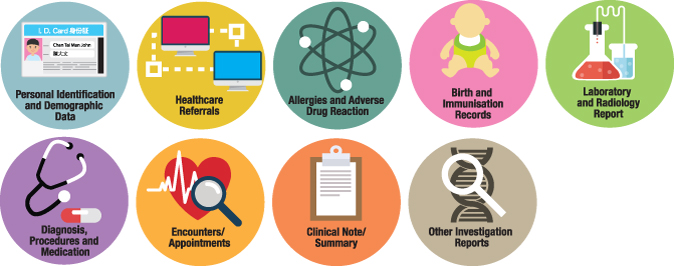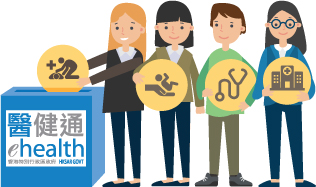 |
|
As part of a consultancy study, a number of engagement meetings are being organised in early 2018 to collect views and ideas from stakeholders on the development of the Patient Portal of the Electronic Health Record Sharing System (eHRSS). This issue of eHealth News gives a highlight of the first session attended by representatives of 3 patient/ patient support groups on 8 February 2018. |
|
|
| |
|
The development of a Patient Portal is one of the
main work targets of the Stage Two
Development of eHRSS. A consultancy study
is being conducted to review relevant overseas
experience, analyse the local environment and
recommend the development directions and
options for the Patient Portal. In order to build a
portal that best suits the local healthcare
environment, a series of engagement activities
has been organised to find out the needs,
expectations and concerns of key stakeholders
since early 2018.
The first session, held on 8 February 2018 at the
Central Government Offices, was attended by
representatives of the Hong Kong Alliance of
Patients’ Organisations Limited, the Society for
Community Organisation and the Patients’
Alliance on Healthcare Reform. Also present
were representatives from the Hospital Authority
(HA) and the Electronic Health Record (eHR)
Office.
|
 |
|
Engagement meetings are being organised to collect views and ideas from stakeholders on the development of the Patient Portal |
|
|
|
| |
 |
| |
|
Patient Portal: An Effective Means for Self-care and Health Management
|
| |
| During the sharing session, participants were invited to share their valuable opinions about the concept of Patient Portal as a platform to engage and empower citizens to more effectively manage their health and acquire health information, with a view to encouraging self-care in the community. |
| |
| In-depth discussions were focused on three major aspects of the Patient Portal, namely access to eHRs and health information by users, value-added functions and data sharing restriction features. |
| |
|
Access to eHRs and Health Information
Participants appreciated the potential capability of the future Patient Portal of enabling patients’ access to some of their eHRs and related health information to facilitate management of health issues according to their individual healthcare needs. They particularly welcomed the idea of integrating existing health promotion information from various sources into a single place. “It is hard for a general citizen, especially the elderly, to access and understand the fragmented health promotion information through different channels,” a participant remarked. “It will be great if patients can easily obtain information about different health programmes of the Government (e.g. the Colorectal Cancer Screening Pilot Programme), or check his/her healthcare voucher account balance on a single platform,” said another participant. Participants also believe that patients could better communicate with their carers if they could access their eHRs, in particular medications and allergy information.
While appreciating the enhanced accessibility of eHRs offered by the Patient Portal, a few participants worried that the medical information on eHRSS, especially the English medical terms, might be too complicated for some patients such as elders. Furthermore, there were concurring views that the ease of information access should be balanced with privacy risks, in particular when such information might be accessed by authorised third parties such as carers of the patients.
|
|
| |
|
Value-added Functions
Regarding value-added functions to be available, representatives of patient support groups shared that allowing patients to input certain health data such as blood pressure or blood sugar measurements through the Patient Portal could help enhance patients’ self-care. Patients would be encouraged to take a more active role in their health management if they could make use of the Patient Portal to monitor their health conditions or disease progress, register with the Government’s health programmes, and set up reminders for medication and medical appointments. Functions to authorise carers to view some of the patients’ eHRs were also considered helpful not only to family members, but also non-healthcare professionals in the community setting in providing primary care and support services to patients. As all participants agreed, the ease of authentication and user-friendliness of the functions are the key success factors of the Patient Portal. |
|
| |
|
 |
|
Participants offered their views and suggestions
regarding the value-added functions of the
Patient Portal
|
|
|
|
| |
|
Data Sharing Restriction
Participants in general welcomed more choices for patients to control the scope of data sharing, especially for those patients with sensitive medical records. Some participants, on the other hand, supported granting full access of patients’ eHRs to healthcare professionals, especially to doctors who could recognise patients’ difficulty in deciding what kind of data to be restricted and in understanding the possible consequences if such data is not shared on purpose.
While respecting the rights of patients in applying certain restrictions on data
sharing, participants in general agreed that certain key information, such as
drug allergy, should not be restricted in view of its critical importance.
All in all, representatives agreed that the design of sharing restriction features in
eHRSS should not be overly complicated. It was preferred to be a simple
function that could offer patients stronger control and privacy protection while
encouraging more patients to join. “Public education and promulgation are
essential to ensure patients are well aware of their rights, obligations and
implications associated with its use,” agreed by all participants.
|
|
| |
Stakeholder Engagement
We sincerely value the views and insights from all participants. Each opinion
counts for the planning, design and development of the Patient Portal.
Further engagement with patient groups and other related sectors, such as
healthcare professional bodies and representatives of the information technology
sector, would continue.
|
|
|
| |
 |
|
Representatives of the Hong Kong Alliance of Patients’ Organisations Limited, the Society for Community Organisation and the Patients’ Alliance on Healthcare Reform were invited to attend the engagement meeting on 8 February 2018.
|
| |
|
| |
|
|
|
|

